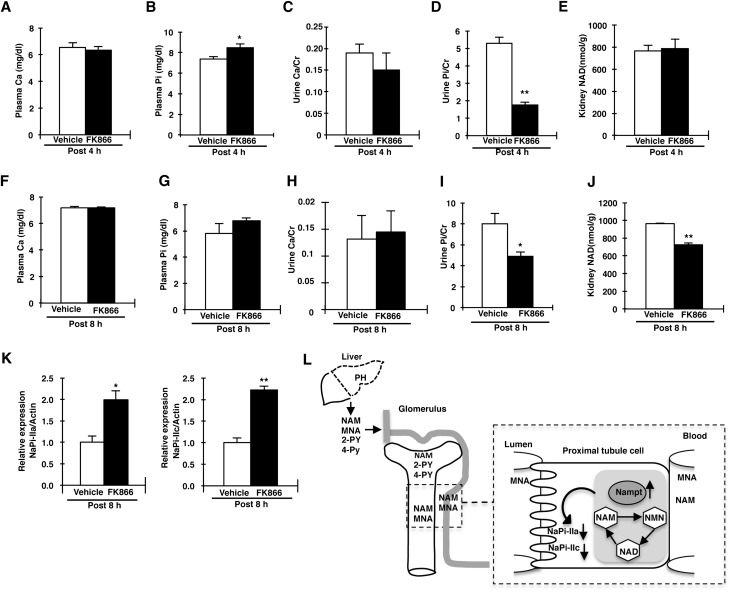Figure 8.
FK866 affects renal Pi reabsorption. C57BL6/J mice (aged 10 weeks) are treated with FK866 (70 mg/kg body weight) by intraperitoneal injection. The concentration of FK866 is selected according to a previous report.31 The open column shows the vehicle injection, whereas the filled column shows the FK866 injection. (A–E) Plasma Ca concentration (A), plasma Pi concentration (B), urine Ca/urine creatinine (Cr) (C), urine Pi/urine creatinine (D), and NAD concentration in the kidney (E) at 4 hours after the administration of FK866 or vehicle (n=8/group). (F–J) Plasma Ca concentration (F), plasma Pi concentration (G), urine Ca/urine creatinine (H), urine Pi/urine creatinine (I), and NAD concentration in the kidney (J) at 8 hours after the administration of FK866 or vehicle (n=8/group). (K) Immunoblotting of NaPi-IIa and NaPi-IIc proteins in kidney BBMVs from FK866-injected mice. BBMVs are prepared at 8 hours after FK866 treatment. All membranes are reprobed for actin. Actin is used as an internal control. (L) Proposed mechanism of hepatectomy-hypophosphatemia through the liver-kidney axis. After PH, NAM and its catabolites MNA, 2-Py, and 4-Py in the liver are released into the blood. MNA is excreted by the kidney, whereas NAM is reabsorbed by the renal proximal tubules. MNA is oxidized in the liver and produces 2-Py and 4-Py, catabolites that are both excreted into the urine. After PH, Nampt protein levels are increased in the renal proximal tubular cells. The increased NAM influx and Nampt activity in the proximal tubular cells leads to the downregulation of the NaPi-IIa and NaPi-IIc protein levels. Data are presented as the mean±SEM (n=8/group). *P<0.05; **P<0.01.

